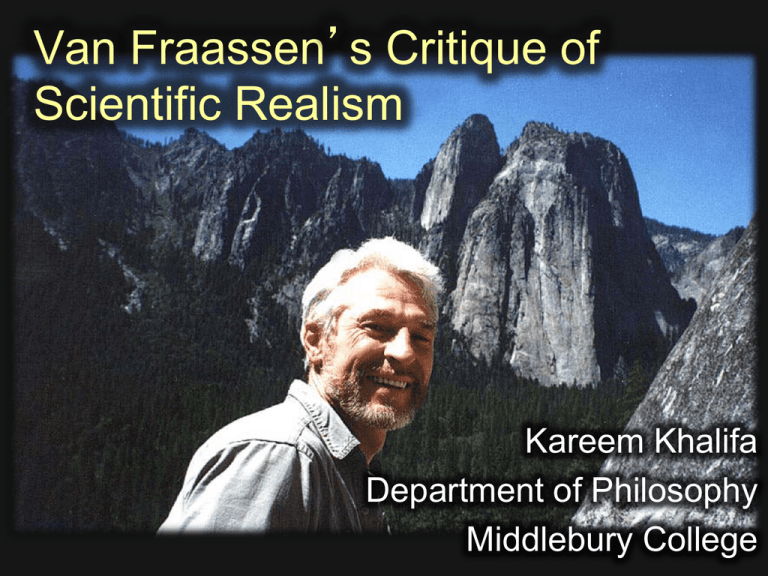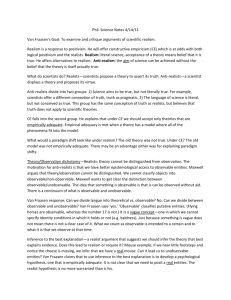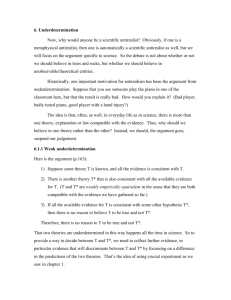PPT
advertisement

Van Fraassen’s Critique of Scientific Realism Kareem Khalifa Department of Philosophy Middlebury College Overview I. Defining Scientific Realism II. Constructive Empiricism III. Defending the Theory-Observation ‘Dichotomy’ IV. Critiquing Inference to the Best Explanation (IBE) I. Defining Scientific Realism A. What realism is not B. Realism defined II. Constructive Empiricism • Two (overlapping) possibilities: – Science aims to be true, but only once properly (but not literally) construed. – The language of science should be literally construed, but its theories need not be true to be good. I choose the second option, and dub it CONSTRUCTIVE EMPIRICISM (CE). Differences between the two antirealisms • Option 1 (non-literal construals of theories): the quark theory doesn’t really say that quarks exist. – Rather statements like “Quarks exist” are useful fictions for theory construction, instruments for organizing data and prediction, etc. • CE: the quark theory says that quarks exist, but it would still be a good theory even if quarks didn’t exist. Constructive Empiricism • Science aims to give us theories which are empirically adequate; and acceptance of a theory involves as belief only that it is empirically adequate. (1069) • Contrast with realism: Science aims to give us, in its theories, a literally true story of what the world is like; and acceptance of a scientific theory involves the belief that it is true. Empirical Adequacy vs. Truth • The quark model would be false but empirically adequate if quarks didn’t exist but everything it said about observable things and events is true. – “Saving the phenomena” (1069) • Applies to future observations, unobserved but observable entities—in short, an empirically adequate theory must save all phenomena. Acceptance, commitment, and belief (1069-1070) • Acceptance = pro-attitude toward a theory, consists of: – Belief = pro-attitude that statements in the theory are true; – Commitment = pro-attitude to “confront any future phenomena by means of the conceptual resources of the theory” (1069); more pragmatic than belief How this bears on realism and CE • Both realism and CE demand that acceptance entails the belief that a theory is empirically adequate • But realism also demands belief that the theory is true – This accounts for the value of explaining phenomena by appeal to unobservables. • In place of this, CE claims that acceptance involves commitment. – As a result, the value of explanation is mostly pragmatic. III. BvF & the Theory-Observation Dichotomy Van Fraassen replies to two potential objections to CE: A. Mediation Objection: If electron microscopes don’t yield direct observation, then neither does anything else. B. Mutation Objection: “Unobservability in principle” = “Observability under different circumstances” A. BvF’s reply to the Mediation Objection • • • • • “Granted that we cannot answer this question [about how to classify observable and unobservable things] without arbitrariness, what follows? That ‘observable’ is a vague predicate.’ (1073) There are no problems with vague predicates so long as there are clear cases of ‘observables’ and clear cases of ‘unobservables.’ A clear case of an observable is anything seen with the unaided eye A clear case of an unobservable is a subatomic particle in a cloud chamber So the concept of unobservability, and hence antirealism, is intelligible. B. Maxwell’s “Mutation Objection” • The theory approach to unobservability: A theoretical entity is unobservable in principle if the theory positing it entails that it is unobservable. • Maxwell: If we had different perceptual capacities, any entity that is unobservable in this sense can be made observable. So there is no difference between “unobservable in principle” and “observable under different conditions than our own.” BvF’s reply to the Mutation Objection (1074-1075) • This is just punning on any concept involving “-able,” i.e., dealing with possibility. – Ex. Is the Empire State Building “portable” because future architects could be much more ingenious than we are? • The proper frame of reference is with respect to what is observable by us, our limitations as human beings. IV. Inference to the Best Explanation (IBE) A. Reminders B. The Ordinary Practice Argument C. Smart’s First Argument D. Smart’s Second Argument E. Sellars’ Thought Experiment F. The Ultimate/No Miracle Argument A. What is IBE? • A pattern of reasoning of the following form: –P – Q best explains P. – Therefore Q. • Example: – I hear scratching in the wall; my cheese disappears. – The best explanation of the scratching and the missing cheese is that a mouse is in the house. – Therefore a mouse is in the house. B. The Ordinary Practice Argument (1076-1077) BvF’s Rebuttal to the Ordinary Practice Argument “we are always willing to believe that the theory which best explains the evidence, is empirically adequate.” (1076) C. Smart’s First Argument (1077-1078) BvF’s Reply to Smart’s 1st Argument D. Smart’s 2nd Argument (1078-1079) BvF’s Reply to Smart’s 2nd Argument E. Sellars’ Thought Experiment (1079-1082) BvF vs. Sellars F. The Ultimate/Miracle Argument (1082-1084) • Theories are empirically adequate. • The truth of theories best explains their empirical adequacy. • Therefore, theories are true. Van Fraassen’s Rebuttal to the Miracle Argument Recap • Scientific realism is the view that scientific theories aim for truth, and acceptance involves the belief that it is true. • Constructive empiricism is the view that theories aim for empirical adequacy, and acceptance involves belief in empirical adequacy + commitment • There are two kinds of argument for scientific realism: – The critique of the theory-observation distinction – The use of IBE • Each argument for scientific realism can be challenged.










